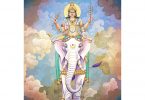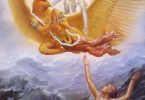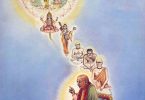Q. How do we justify explanation of eclipses given in the Vedas as Rahu swallowing Chandra etc, while science gives explanations of shadows of one falling over other?
Answer by Romapada Swami: First, I would like to make a general comment that it is not quite necessary to justify evidence from shastras or try to reconcile them in light of modern discoveries. Vedic truths stand on their own authority and also have their own deeper reason and logic even though it may not seem evident to us. According to Vedic methods, the modern scientific methods are lesser methods of arriving at truth and knowledge, and as we know all too well, they are ever subject to revision. (Please see Digest #149 for more detailed discussion on this topic). Thus whenever there seems to be a discrepancy between Vedic statements versus the evidence of our sense perception or empirical scientific experiments, we can assume that it is the empiric conclusion that might be in need of justification and revision!
Let us now turn to have a clearer picture of what the Vedic sciences really have to say about eclipses. Perhaps it may come as a surprise to some that the explanation based on the shadow theory was not unknown to Vedic astronomers. There has been, since time immemorial, a strong tradition in Vedic culture where people’s daily life was tightly interwoven with and constantly regulated by astronomical and astrological considerations. Intricate ritualistic ceremonies and religious duties were connected to astronomical events, and complex astrological and calendrical calculations were regularly performed by highly learned brahmanas. Vedic calendars since ancient times have had accurate predictions of the eclipses. For example, we hear in the pastimes of Krishna that once there was a rare type of solar eclipse which was predicted by astronomical calculation, and people from all over India traveled to arrive at Kurukshetra in anticipation of this occasion. (Krishna Book Ch 82)
The body of Indian astronomical literature called jyotisha shastra gives computational rules to predict the occurrence of both lunar and solar eclipses and even compute the degree to which the disc of the sun or moon will be obscured! These calculations are based on the model that eclipses are caused by the passage of the moon in front of the sun or into the earth’s shadow. At the same time, rules are also given for calculating the position of Rahu and another similar planet named Ketu, which are invisible planets whose positions, notably, correspond to the ascending and descending nodes of the moon (the points where the orbit of the moon intersects the ecliptic, or the orbit of the sun), respectively. It turns out that either Rahu or Ketu will always be lined up in the direction of any solar or lunar eclipse. (Reference: Vedic Cosmography and Astronomy by Sadaputa Dasa)
Modern scholars tend to hypothesize that these calculations are probably later introductions borrowed from the Greek, but there is no real evidence to this and there is nothing that suggests that the transfer of knowledge might not have happened the other way round, (viz. India to Greece) given the fact that astrology and the influence of planets such as Rahu and Ketu have played such a vital role in Vedic society for centuries. We can conclude that these methods of calculation were in common use in India at least since Krishna’s time, i.e. 5000 years ago.
This may then raise the question that if such astronomical sophistication was indeed known to Vedic sciences, then what about the stories involving Rahu being the head of a demon decapitated by the Mohini incarnation. One might tend to think that perhaps these are just superfluous or mythological stories with no substance to them and were simply added on as poetic interpretations to entertain the common man. However, Vedic accounts have multiple levels of meanings embedded in them and thus descriptions of the personalities such as Surya, Candra (the presiding deities of sun and moon), or Rahu and Ketu need not preclude their simultaneously being astronomical entities.
One may raise the objection that if these celestial bodies are in fact controlled by divine personalities, how is it that they obey such precise patterns and predictable natural laws. But even within our day-to-day experience it is not impossible to find highly regulated protocols and routine procedures being executed by human beings.
In summary, physical and astronomical explanation and calculation of eclipses were an integral part of Vedic sciences, and in addition the narration of Rahu chasing the sun and moon are not merely poetic myths but factual accounts which may contain multiple levels of meaning, both astronomical as well as involving personal deities.
Please refer to Digest 729 for related information around eclipses







